U.S.S. Gerald R. Ford, the world's most powerful aircraft carrier: "It is a monument to American might"
The $13 billion vessel can carry 100,000 tons, including more than 4,000 crew, 70 aircraft and state-of-the-art weaponry.
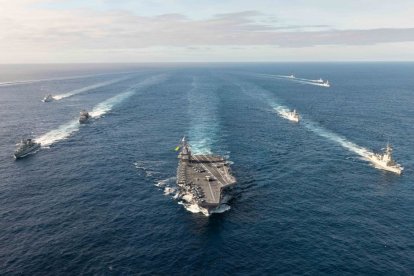
(Flickr / NATO)
It’s the newest, largest and most technologically advanced aircraft carrier around. That is how the Atlantic Alliance defines the first aircraft carrier designed by the United States in 40 years: the U.S.S. Gerald R. Ford (identified by the initials CVN-78).
In April, the ship and its 100,000 tons of cargo sailed the seas for the first time on full deployment. It made a short test deployment in 2022. The ship is estimated to complete approximately 50 years of Navy service, interrupted by a single refueling in the middle of this period.
"This is American craftsmanship at its biggest, at its best, at its finest," then-President Donald Trump said when the ship entered service in 2017. "There is no competition to this ship. It is a monument to American might that will provide the strength necessary to ensure peace."
To get to that point, the United States spent $13.3 billion to build the Ford, according to a report to Congress. The same document notes that this figure represents $1.4 billion more than originally budgeted.
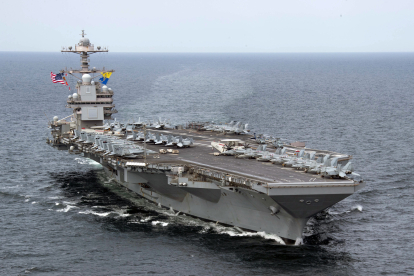
USS Gerald R. Ford (CVN 78) crossing the North Sea (America's Navy)
Military capability
"These aircraft carriers are truly designed for the 21st century and beyond," says defense builder and supplier Huntington Ingalls Industries (HII), which boasts the only shipyard building such vessels for the Navy since 1960.
The Gerald R. Ford class, the model to which the eponymous CVN 78 aircraft carrier belongs, is nuclear-powered. Specifically, it has two Bechtel A1B nuclear reactors designed specifically for this vessel that allow it to reach up to 30 knots of speed, about 35 miles per hour. They produce nearly three times more power than their predecessor, the Nimitz-class, according to the Navy Lookout website.
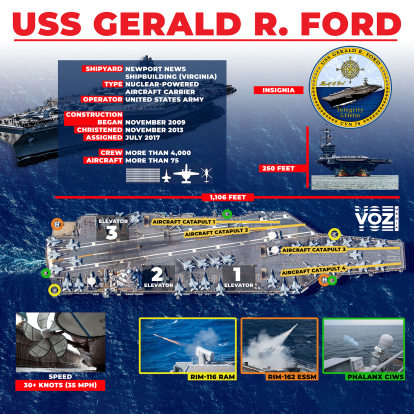
230319-N-TL968-1357
On board the CVN-78 is also a veritable arsenal. It has missiles to repel both sea and air attacks, including two RIM-116 RAM (light, fast-reaction missiles), two RIM-162 ESSM (designed to counter supersonic missiles) and three Phalanx CIaws (rapid-fire, radar-controlled).
In addition, it has state-of-the-art radar systems to detect threats and track targets. There are two, the Raytheon AN/SPY-3 3D and the VSR (Volume Search Radar). Four other radars are used to fine-tune its direction of fire and another, the Raytheon AN/SPS-73V, to guide its navigation.
Catapulting aircraft into the ocean
Despite the nuclear reactors, the defensive material, the thousands of crew members and corresponding supplies, the Ford still has room to fulfill the original purpose of aircraft carriers: it can accommodate more than 75 aircraft.
For this purpose, it needs to transport the necessary pilots and technicians, in addition to having a system of elevators to raise the aircraft that are stored in lower levels of the ship.

Sailors carry ammunition from an aircraft aboard the USS Gerald R. Ford (America's Navy).
One of the ship’s most innovative technologies, and one that has been questioned due to its high cost and repeated failures during testing , is the Electromagnetic Aircraft Launch System (EMALS). In other words, it is a catapult that assists aircraft in takeoff.
Unlike the previous system, which operated with steam, EMALS launches and recovers aircraft electromagnetically. The aircraft is hitched to a trolley that runs along a horizontal rail. Among the advantages of this propulsion method, the Naval Post lists that it requires fewer personnel for maintenance, takes up less space and can support heavier aircraft than its predecessor, as it generates 30% more energy.
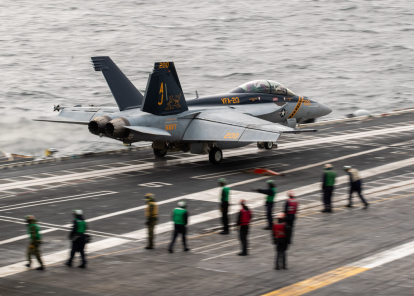
An F/A-18F Super Hornet takes off from the deck of the USS Gerald R. Ford (CVN 78). (America's Navy)
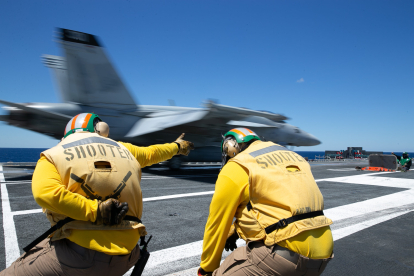
Sailors launch an F/A-18E Super Hornet during flight operations in the Atlantic Ocean (America's Navy).
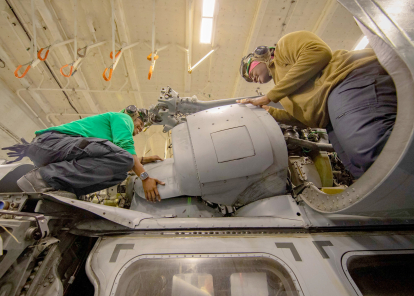
Machinists perform routine maintenance on an MH-60S Sea Hawk helicopter in the hangar of the aircraft carrier USS Gerald R. Ford (CVN 78). (America's Navy)
A navigable city
"Day and night, the ship buzzes with activity," described NATO multimedia producer Rob Kunzig after a two-week voyage aboard the "floating behemoth."
In total, there are 14,000 meals served per day. A team of culinary specialists works around the clock in the ship's two kitchens, using state-of-the-art technology even in the ovens: "They are equipped with a screen that displays a menu of products that are cooked at the touch of a button."
This was explained by Ford officials Jason Teasley and Chris M. Buchanan of Ford Food and Procurement Services, who further detailed:

Culinary specialist Vertyle Charles grills chicken aboard the USS Gerald R. Ford (America's Navy).
Nine decks below the kitchens, connected by elevators, are the refrigerators and storage rooms. These have space to feed the entire crew for at least four weeks, with replenishments at sea every two weeks.
And that's just for the kitchen. The Ford also has a cafeteria, medical facility and a gymnasium.

Weightlifting 'party' in the hangar bay of the USS Gerald R. Ford (America's Navy). https://www.navy.mil/Resources/Photo-Gallery/igphoto/2003190660/
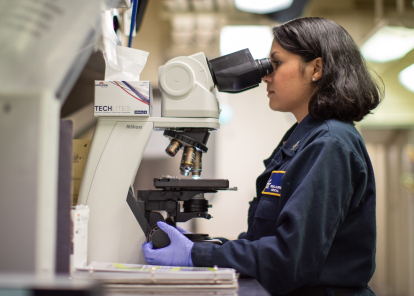
A member of the medical department of the USS Gerald R. Ford (CVN 78) performs a microscopic examination of urinary sediment in the medical laboratory (America's Navy).
China not so impressed
The Chinese Army announced shortly after the U.S. aircraft carrier was launched that if it needed to, if it wanted to, it could sink the ship.
To prove it, they used war-gaming software. According to this simulation, 24 hypersonic missiles would be enough to finish the ship off, as 20 simulated battles proved. This is according to research by the North University of China, according to the Chinese outlet South China Morning Post.
The same newspaper warns, however, that military experts point out that the effectiveness of these missiles varies, so caution is advised when considering the results of these simulations.
Where are the aircraft carriers?
“In times of crisis, the first question leaders ask is: ‘Where are the carriers?’” Such is the importance of these warships in U.S. naval strategy, according to public Navy documents.
Before World War II, the main purpose of aircraft carriers was reconnaissance and observation of enemy capabilities; deploying, of course, a fleet of aircraft for that purpose. They were often converted cruisers or merchant ships. This is the case of the first American aircraft carrier, the USS Langley, a ship that originally carried cargo under the name USS Jupiter.

First American aircraft carrier, the USS Langley.
During World War II, they became increasingly important as their technological capabilities improved. Their value continued to rise during the Cold War to the importance they have today.
The Navy maintains that the mere presence of one of these vessels often serves as a deterrent to enemies. They also claim that they are often used for maritime security operations, such as preventing terrorist or pirate attacks on merchant ships.
Disaster relief is another of the ship’s many objectives. This includes, for example, taking advantage of its helicopters to provide humanitarian aid in the event of natural disasters.
More to come
The CVN-78 is only the first of the Ford class. The Navy has already begun the process to accompany it with three other ships of the same type: the CVN-79 (for which $624 million was requested in the 2024 budget), the CVN-80 ($1.1 billion) and the CVN-81 ($800 million).
In 2025, the Navy should take delivery of CVN-79, to be named John F. Kennedy. The aircraft carrier named in honor of the former president is already under construction. It will be followed, if the Navy's plan is followed, in 2028 by the CVN-80, named Enterprise, and in 2032 by the CVN-81, christened Doris Miller.
RECOMMENDATION





















